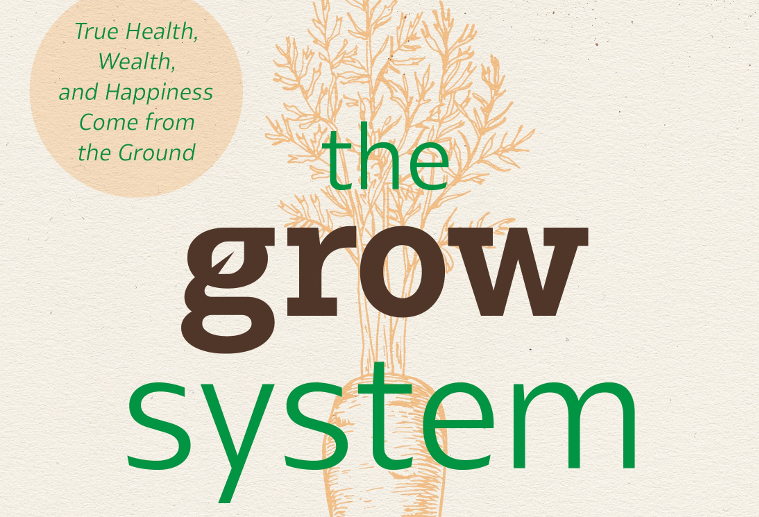Ed. note: This post is excerpted from The Grow System, written by Marjory Wildcraft and published by Penguin Random House. You can find out more about the book and purchase it here. This excerpt is published on Resilience.org with permission.
I was nervous. Although I had excitedly volunteered to teach gardening at a local school, now I was in front of a group of uninterested middle-schoolers, and I was seriously wondering how big this failure would be. Very few of these children ate vegetables regularly, cheap fast food was a staple, and most of them were envious when another student showed up with a Lunchable in their pack. I did have some things working in my favor to get their attention. Being outside on the sunny playground was definitely a step up from being inside the classroom. The kids were happy to do practical work and help construct the raised bed garden. Showing them how to safely use the power drill to screw the boards together conveyed trust and built confidence. And even though some of the kids were a little small, they took on the challenge of using the grown-up shovels to unload the truck and fill the bed. They loved the rich smell and moist, crumbly feel of the dark earth between their fingers as they shaped and smoothed the soil. I beamed at how excited and tender they were while transplanting the starts and taking on the duties of regular watering and weeding. I had chosen some strawberries and snap peas to plant — classic favorites that are pretty much guaranteed to go over well with kids, but in most of the garden, I had them plant oak leaf lettuce, kale, turnips, chard, radishes, mustard greens, and broccoli.
That was what made me worried. The only salad many of these kids had ever eaten was wilted iceberg lettuce and perhaps a pale, sad excuse for a tomato. They had never tasted most of what we were growing. If I could get them to try the kale, would they spit it out? A few weeks later, when the greens got big enough to start picking (they come up pretty quickly), I put some small containers of ranch dressing in the classroom fridge. I showed the kids how to harvest a lettuce leaf, dip it in the dressing, and eat it, and I let them know they could do that whenever they wanted. When eating the greens started to become a “thing” at recess, I was fist pumping and jumping with joy. The kids absolutely loved the lettuce, kale, chard, and broccoli.
The spicy zing of the mustard greens and radishes was an exciting flavor most had never experienced before, and they ate it up. After a while, the children didn’t even need the ranch dressing to enjoy the veggies. They started munching on the greens directly from the garden between games of tag or hide-and-seek. My advice to those of you who say you don’t like vegetables is . . . try homegrown. If you’ve never eaten homegrown vegetables, then you’ve never really eaten vegetables! The vegetables you find at your supermarket are grown using industrial methods that give them a bland flavor. They also have to make a multiple-day journey through the supply chain between when they are picked and arrive at your market. Homegrown produce is almost like a different food group. Its bright taste and freshness are unmatched, and it can win over even the pickiest eaters. My own kids were raised on homegrown food, and growing up, they loved vegetables. But on the rare occasion when I purchased store-bought broccoli, it would be left on the dinner table untouched, alone, and uneaten. Good produce has always been part of my family’s lives, and they have developed discerning palates.
More Than Just a Garden
I probably don’t have to tell you that if you opt to buy pesticide-free, organic produce— foods that are healthier for both you and the environment— you are looking at some high grocery bills. But when you grow your own tomatoes and other favorite foods, you’ll be amazed by how much money you can save. Along with the cost- saving benefits, having easy access to fresh vegetables from your backyard will transform your meals and dramatically improve your family’s habits and health. A backyard garden also helps strengthen your relationship with your community. I really felt the power of my strongly knit community a number of years ago when I got a call from a guy I knew who had recently started an organic greenhouse to grow tomatoes. His first attempt at growing them had failed, and so did his second, but the third time was a charm. He produced so many tomatoes, he didn’t know what to do with them all.
“Hey, Marjory,” he said to me when I answered the phone. “If I showed up tomorrow with a trailerful of fresh, organic, fully ripe tomatoes, would you want them?”
“Give me five minutes to figure it out, and I’ll get back to you,” I told him. I then called two neighbors, and within minutes, we had organized a community canning party at one of their homes. The next day, my entire family and several others showed up to slice and dice tomatoes, sterilize the jars, and pack them full. The kids were there, occasionally helping out and occasionally running out. One neighbor had an eight-month-old, and whoever needed a break would take a turn holding the baby. It was a magical, wonderful day filled with good food, great company, and lots of useful work. At the end of it, each family went home with two years’ worth of fresh, delicious tomato sauce. Now in our community, when one of us has a bumper crop of something, we share it. If we need help with a big harvest, we call the neighbors. We’ve formed an incredible support system, and all our lives are richer, more fun, and more secure as a result. I want to create a movement of families and communities who have these kinds of strong bonds, better health, greater happiness, and more self-sufficiency. I want people to come together to increase the value and meaning in their own lives. But we’ve got to take the first steps to make that happen! An oak doesn’t spring up from the ground fully grown. You have to start small, with practical, manageable goals. So how do you get started? In the following section, I give you step-by-step instructions with a basic “recipe” for creating your own backyard garden. Then I offer tips for taking it to the next level and provide inspiration to keep you going.





